Snuhi Sehund: Euphorbia neriifolia Uses, Side effects, Research
Snuhi- Euphorbia neriifolia, also called Sehund, is an Ayurvedic herb used for the treatment of swelling, for purgation, cough, rhinitis and piles.
Latin name- Euphorbia neriifolia Linn.
Family- Euphorbiaceae (Eranda kula)
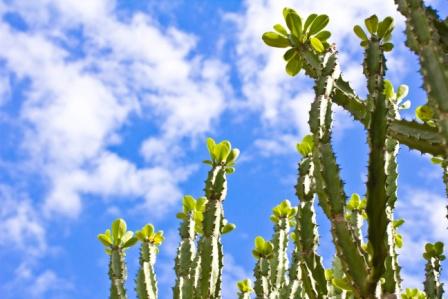
Table of Contents
Vernacular names
Names in different languages:
Hindi name-Sehund, Danda thukar
English name- Common milk hedge
Arabic name- Jakum
Kannada name- Male kalli
Marathi name- Thor
Malayalam name- Illa kalli
Punjabi name- Thor
Telugu name- Akujemuddu
Tamil name- Ilaikalli
Morphology
Morphology of Euphorbia neriifolia:
It is a small tree or big shrub growing to a height of 10-20 feet in dry regions of India. The genus has over or about 2,000 members. The trunk and the branches are modified into round or irregular shape. The leaves are shrunk into spikes, fleshy in nature. Flowers when viewed as a whole, looks like a single flower. It has a unique kind of pseudanthium, called a cyathium, where each flower in the head is reduced to its barest essential part needed for sexual reproduction. These flowers have no sepals, petals, or other parts that are typical of flowers in other kinds of plants. The fruits are 0.5 inch long. Flowers and fruits are seen in the spring season.
Properties, part used, dosage
Snoohi medicinal properties:
Rasa (Taste) – Katu (Pungent)
Guna (Qualities) – Laghu (Light for digestion), Teekshna (Strong)
Vipaka – Katu (Undergoes Pungent taste after digestion)
Veerya (Potency) – Ushna (Hot)
Karma (Actions) – Kaphavata shamaka (reduces vitiated kapha and vata dosha)
Pharmacological action -Purgative, Hepatoprotective, Anti inflammatory and Insecticidal
Part used- Root, Leaf, Milky latex
Dosage-
Root powder- 0.5 to 1 g
Stem juice- 5 to 10 ml
Milky latex- 125-250 mg
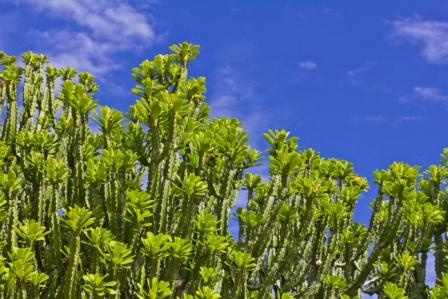
Sanskrit verse
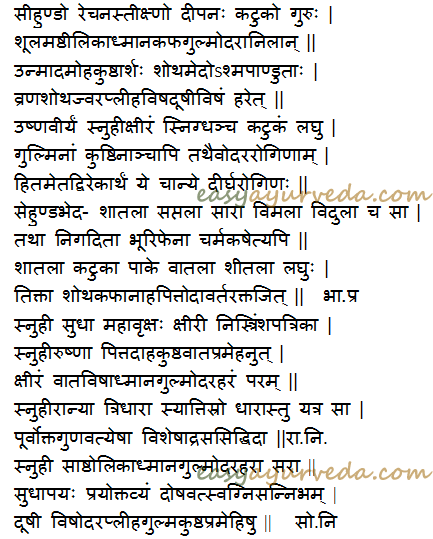
Chemical composition
Chemical composition of Euphorbia neriifolia:
The triterpenoids, euphol, 24-methylene cycloartenol, euphorbol hexacosonate, glut-5 (10)-en-5-one, glut-1- en-3 beta-yet-acetate, taraxerol, friedelan-3 alpha-ol and–3 beta-ol have been reported from the plant.
Uses of Snuhi
- The leaf of Snuhi is heated and tied over the area affected with pain and inflammation.
- The fresh juice from the leaf is poured inside the ears to treat earache.
- Oil processed from the leaf of Snuhi and sesame oil is used for external application to treat joint pain.
- The fresh milk latex of Euphorbia neriifolia is applied over external pile mass to reduce it.
- Milk latex is used in the preparation of ‘Kshara sutra’, a medicated thread useful to treat piles and fistula.
- Juice from the fresh stem of Snuhi is added with honey and borax to treat cough and sore throat.
- The milk latex of Euphorbia neriifolia is applied over warts as part of treatment.
- The milk latex can cause purgation; hence it is used for cleansing the abdomen in cases of poisoning and in severe constipation.
- The paste of the leaf of Snuhi is applied over the skin to treat skin diseases.
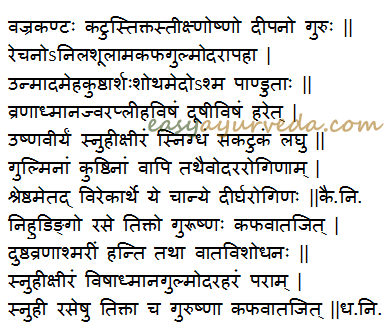
Traditional uses of Sehund as per Ayurveda:
Deepana – improves digestion strength
Rechana – induces severe purgation
Anilapaha – Vatahara – useful in treating disorders of Vata Dosha imbalance such as neuralgia, paralysis, constipation, bloating, etc
Snigdha – unctuous, oily
Laghu – light to digest
Indications
Indicated in –
Shoola – abdominal colic pain
Ama – A product of indigestion and altered metabolism
Kaphaja gulma – tumor of Kapha origin
Udara – ascites, enlargement of the abdomen
Unmada – Schizophrenia
Meha – diabetes, urinary tract disorders
Kushta – skin diseases
Arsha – hemorrhoids
Shotha – Swelling, inflammation
Meda – obesity, high cholesterol
Ashmari – Kidney and bladder stones
Pandu – anemia
Vrana – Ulcers, wounds
Adhmana – bloating, gaseous distension of abdomen
Jwara – fever
Pleeha – Disease of the spleen, Splenomegaly
Visha – Toxic conditions, poisoning
Dooshivisha – chronic poisoning
Dushta Vrana – infected wound
Snuhi variety, called Shatala, with synonyms Saptala, Sara, Vimala, Vidula yields profuse latex with frothing. It is Katu – pungent
Tikta – bitter
Indicated in
Shotha – Swelling, inflammation
Kapha Anaha – bloating, fullness
Udavarta – bloating
Raktapitta –Bleeding disorders such as nasal bleeding, heavy periods, etc
Varieties Acc. to Charaka
Alpa kantaka
Bahu kantaka
Side effects
Excess use of Snuhi can cause severe purgation and if the milk of the plant falls to the eye, it can cause blindness. Hence Snuhi should be used always under medical supervision.
Toxic effect
Latex of Snuhi is found to be a powerful contact poison but weaker as a stomach poison. Produce excruciating pain and severe inflammation if it gets into a cut on skin or into eyeball, may result in ulceration of the eyeball.
Cause severe burning sensation if contact with skin
Internal administration in excess quantities causes vomiting and diarrhea. Blood mixed stool may be seen.
Antidote
Milk, ghee
Interaction with medicines, supplements
Can this be used while taking Homeopathic medicine?
Yes. This product does not react with homeopathic medicine.
Can this medicine be continued while taking supplements like multivitamin tablets, Omega 3 fatty acids etc?
Yes. Generally, this product goes well with most dietary supplements. However, if you are taking more than one product per day, please consult your doctor for an opinion.
With western
medicines
Seek your
doctor’s advice if you are taking this product along with other western
(allopathic / modern) medicines. Some Ayurvedic herbs can interact with modern
medicine.
If both Ayurvedic and allopathic medicines are advised together, then it is
best to take Allopathic medicine first, wait for 30 minutes and then take the
Ayurvedic medicine.
Ayurvedic medicines
Ayurvedic medicines containing Snuhi:
Agnivrana Taila: It is an Ayurvedic medicated oil used for the treatment of burns, boils, prevention of blisters etc.
Ayaskirti: It is an Ayurvedic medicine used for the treatment of anemia, weight loss therapy, skin diseases, irritable bowel syndrome etc.
Vishatinduka taila: It is an Ayurvedic medicine used for the treatment of Gout, numbness, skin diseases with discoloration. The oil is applied externally.
Abhaya lavana: It is an Ayurvedic medicine, used in the treatment of liver and spleen disorders. It is in powder form.
Madhusnuhi rasayana: It is a formulation used in the treatment of skin diseases like eczema, psoriasis, diabetic carbuncles, fistula, piles, tumors, goiter, itching, rheumatoid arthritis and non- healing wounds.
Ardraka ghrita: It is a medicine in ghee form and is useful to treat indigestion, chronic diarrhea, gastritis etc.
Arsha kutara rasa: It is an Ayurvedic medicine in tablet form. It is used in the treatment of hemorrhoids.
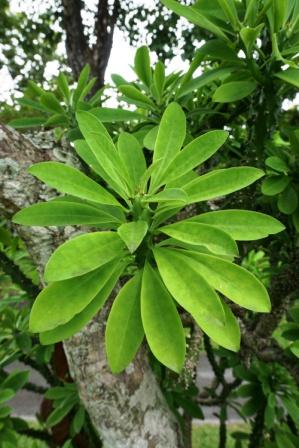
Jalodarari rasa: It is an Ayurvedic medicine used in the treatment of ascites and hepatic disorders.
Shanka dravaka: It is an Ayurvedic medicine used for the treatment of ascites, indigestion, diseases of the liver and spleen.
Snuhi Kshara
Synonyms – Snuk Kshara, Vajra Kshara ad Sehunda Kshara.
Properties
स्नुहीक्षारः स्मृतस्तीक्ष्णः सर्वोदरविनाशनः ।
गुल्मप्रशमनो वह्निदीपनः शोफनाशनः ॥
विषूचिकाहरोऽजीर्णनाशनः शूलसूदनः ।
यकृद्दोषप्रशमनः श्वासातङ्कप्रभञ्जनः ॥ (र.त.१४/९२,९३)
snuhīkṣāraḥ smṛtastīkṣṇaḥ sarvodaravināśanaḥ |
gulmapraśamano vahnidīpanaḥ śophanāśanaḥ ||
viṣūcikāharo’jīrṇanāśanaḥ śūlasūdanaḥ |
yakṛddoṣapraśamanaḥ śvāsātaṅkaprabhañjanaḥ || (ra.ta.14/92,93)
tīkṣṇaḥ – sharp,
sarva udara vināśanaḥ – cures all types of ascites,
Gulma praśamano – cures abdominal lump,
Vahni dīpanaḥ – enhances digestion strength,
Śopha nāśanaḥ – subsides swelling,
viṣūcikā hara – cures gastroenteritis
ajīrṇa nāśanaḥ – cures indigestion,
śūlasūdanaḥ – subsides pain
yakṛd doṣa praśamanaḥ – pacifies all problems related to liver,
śvāsa ataṅka prabhañjanaḥ – cures asthma.
Research
Research articles related to Euphorbia neriifolia:
Anti- microbial study: The phytochemical analysis of leaf extracts (chloroform, ethanol, ethyl acetate, butanol and aqueous) of a medicinal plant, Euphorbia neiirifolia and their antibacterial activities against bacterial isolates, Staphylococcus aureus, Klebsilla pneumoniae, Escherichia coli, Proteus vulgarius, Pseudomonas fluroscens were investigated. the presence of flavonoids, phlobatannins, saponin, tannins, cardenoloids, phenol, terpenoids. The maximum activity was observed in chloroform extract against P. vulgarius with zone of inhibition (8 mm), followed by ethanol extract against K. pneumonia (5 mm). This research supports the local use of the leaf of the plant, E. neiirifolia for wound healing properties and other forms of bacterial infections.
Protective action on induced thrombosis: The present work was designed to study antithrombotic potential of E. neriifolia Linn. Carrageenan-induced rat tail thrombosis model was used to study the anti-thrombotic effect by measuring thrombosis of tail and bleeding time as well as clotting time. In the present work, Phyto-constituents like flavonoids and polyphenols could be responsible for demonstrating protective effects on experimentally induced thrombosis in murine models.
Wound healing activity: The wound healing effect of aqueous extract of the latex of Euphorbia neriifolia was evaluated in guinea pig. Surgically produced cutaneous wounds were treated with topical application of 0.5% and 1 .O% sterile aqueous solution of the extract. The extract facilitated the healing process as evidenced by increase in tensile strength, DNA content, epithelization and angiogenesis.
Antioxidant action: The antioxidant activity of EN extract was evaluated by various antioxidant assays such as TAC, FRAP, FTC, TBA and non specific activity. All these antioxidant activities were compared with standard antioxidants. Phytochemical screening and the total phenolics, flavonols and
proanthocyanidin content was also determined. A positive correlation between the antioxidant
activities and physicochemical assays were observed and the highest scavenging activity of extract was noticed at concentration of 1mg/ml.
Classical categorization
Dhanvantari Nighantu- Guduchyadi varga
Bhavaprakasha- Guduchyadi varga
Raja Nighantu- Shalmalyadi varga
Kaiyyadeva Nighantu- Oushadhi varga
Shodala Nighantu- Guduchyadi varga
Botanical classification
Kingdom: Plantae
Order: Malpighiales
Family: Euphorbiaceae
Subfamily: Euphorbioideae
Tribe: Euphorbieae
Subtribe: Euphorbiinae
Griseb.
Genus: Euphorbia N.
Sanskrit Synonyms
Sudha- Has white colored latex
Samanth dugdha- Has milk all over the body
Vajradruma, Vajrakantaka, Kulisha Druma, Vajravruksha, Vajratunda, Vajri- It has strong action like diamond, branches are diamond shaped in cross section
Nistrisha patra- The structure is sharp like sword
Mahavriksha- The shrub grows to a good height
Vatari – balances Vata Dosha.
Ksheerakanda, Bahushrava – Yields profuse latex
Vyaghranakha, Guda, Gudakhya, Gandeera, Sehunda, Snuk, Snuhi, Sihunda, Nihunga, Simhatunda, Shakhakhanda,
Bahushakha – multiple branches
Dandavruksha – branches are like log of woods
Author: Dr.B.K.Prashanth M.D (Ayu), Ph.D
E mail: [email protected]
Click to consult Dr Prashanth BK
Sthanika Karma (Systemic Action)
External – Stem and leaf have analgesic and scraping actions. Its leaf, which is hot and can be kept on the joint, helps to reduce pain. Juice can be used for ear pain. Oil prepared out if it can be used for external application in vata rogas. Its latex can be used for skin disorders, toothache, erectile dysfunction, etc. Latex is applied to thread and can be used for tying the base of hemorrhoids. In fistula, for the ksharasutra technique, the tread is smeared with its paste and can be used.Digestive System – Best among strong purgative herbs. Anthelmintic. Overdose can cause abdominal discomfort. Indicated in Ascites, Liver and spleen enlargement, for purgative purpose.
Circulatory System – Indicated in Rheumatic heart diseases, Joint pain, etc.
Respiratory system – Expels out vitiated kapha dosha. Stem juice along with honey can be administered in cough, breathing disorders, Rhinitis etc.
Skin – Indicated in skin diseases.










